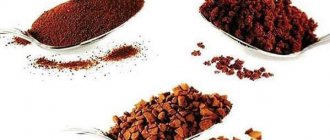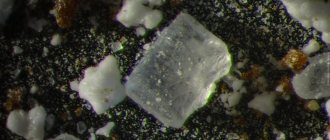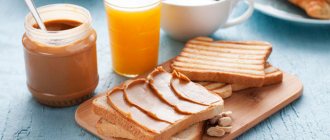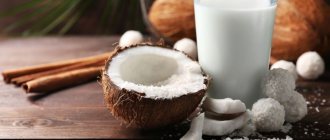A cup of coffee will help you wake up in the morning, invigorate you in the afternoon and give you a burst of strength, energy and mental activity in the afternoon. The delightful aroma and unsurpassed taste have made this drink one of the most popular all over the world. Almost everyone drinks it. However, many people don’t think about how many calories are in coffee, depending on the type and the presence of various additives? Does it have harmful properties and what are they? How much coffee can you drink per day? We will consider the answers to these and many other questions below.
Coffee calories
Calorie content of raw materials per 100 grams, depending on its type:
- granulated, instant coffee - 94 kcal;
- in grains - 223 kcal;
- ground - 201 kcal.
As you can see, the lowest calorie coffee is granulated. On average, take a heaped teaspoon for one cup (200 ml) - this is approximately 8 grams of raw material. It turns out that one cup of granulated instant coffee without milk, sugar, butter or condensed milk contains only 7.5 kcal. By the way, freeze-dried instant coffee has the same calorie content.
Photo source: shutterstock.com
Now let's calculate the energy value of one mug of a drink made from natural beans and ground coffee. To calculate, we again take 1 heaped teaspoon of raw materials per cup. These indicators are adhered to in most recipes for Turks, coffee machines, etc. Accordingly, we will need 8 grams of coffee. We carry out simple calculations and find out that:
- a cup of coffee beans - 17.84 kcal;
- a cup of ground coffee - 16.08 kcal.
However, the nutritional value of coffee in its pure form is low. Let's consider the average indicators of BJU (proteins / fats / carbohydrates) of raw materials per 100 grams:
- granulated, instant coffee - 15/3.5/0;
- in grains - 13.9/14.4/15.6;
- ground - 13.9/14.4/4.1.
As you can see, granulated coffee contains absolutely no carbohydrates, and the amount of protein and fat is low.
Calorie table for the most popular coffee drinks
To make it more convenient to immediately find the calorie content of the drink you are interested in, you need to use the table:
| Drink name | Number of kcal in one serving |
| Natural coffe | 1-2 |
| Americano | 15 |
| Latte | 250 |
| Cappuccino | 150 |
| Mochaccino | 290 |
| Frappuccino | 400 |
| Glasse | 125 |
| Latte Macchiato | 60 |
| Instant coffee | 14 |
So, coffee is a delicious drink that itself contains very few calories, which is why it is allowed on almost all diets. The calorie content of coffee increases rapidly if you add milk, cream, sugar, condensed milk or chocolate syrup to it. To make it easier to monitor the amount of calories in your diet received along with coffee, it is convenient to use the table and the calorie values of coffee additives.
How many calories are in 1 cup of coffee:
♦ Category: Healthy products.
Read for Health one hundred percent:
- How many calories are in tomato juice from different manufacturers?
- The benefits and harms of white chocolate: history, composition and calorie content
- It’s interesting to understand the benefits of chicory
- Dietary educational program: how many calories are in fish
- Tea with lemon balm - enjoying life and health benefits
- No need for migraine pills?
- Products containing proteins, fats, carbohydrates: tables, descriptions, features
- How to eat healthy and healthy with chronic pancreatitis
Calorie content of coffee with sugar
The calorie content of a teaspoon of sugar is 25 kcal. If you add 2 or 3 teaspoons to coffee, the calorie content of the drink will increase by 50 or 75 kcal, respectively. Most often, a couple of teaspoons of sugar are added to a cup of coffee (200 ml).
Photo source: shutterstock.com
Thus, the final calorie content will be as follows:
- granulated, instant coffee - 57.5 kcal;
- in grains - 67.84 kcal;
- ground - 56.08 kcal.
But the nutritional value of sweet coffee will change more compared to bitter coffee without sugar. So, proteins, fats and carbohydrates are equal to 1.29/0.66/9.29 g, respectively.
How many calories are in 100 grams of coffee?
Coffee itself has very low calorie content. Given this and its ability to speed up metabolism, this drink is used by nutritionists. The method of preparing coffee, the type and amount of additives used directly affect the calorie content. No matter what we add to a mug of coffee, the number of calories will increase, so if you want to lose weight, it is better to avoid additives.
For overweight people, daily consumption of cappuccino, Viennese coffee or ice cream with ice cream will not benefit their figure. Such drinks are recommended for those who burn a lot of calories a day (for example, people with heavy physical activity, athletes), because they can replenish the energy spent with a coffee cocktail with cream and sugar.
The calorie content of coffee drinks depends on their composition. Instant coffee can contain not only beans, but also certain cereals, flavorings, chicory, and ground nuts. Milk and cream are added to espresso and Americano. The more there are, the “heavier” its “weight”.
The main types of coffee and drinks produced from it:
- Natural (espresso, Americano).
- Soluble.
- Latte.
- Cappuccino.
- Mocaccino.
In black natural
Black custard has the lowest calorie content. There are only 2 kcal per 100 ml. Good news for lovers of Americano - it contains only 1 kcal, espresso a little more - 4. These few calories appear due to the tiny amount of fatty oils and protein found in the beans. Because of these oils, coffee sometimes tastes bad - if slightly over-roasted beans are stored on the shelf for a long time, the extracted oils begin to deteriorate, adding bitterness. If you drink only an Americano or espresso with water, then you don’t have to worry about calories, since there are very few of them.
In soluble
The calorie content of instant coffee is slightly higher than natural coffee and is 7 kcal per 100 ml. A standard mug has a capacity of 250 ml, which means that after drinking it, you will only get 17.5 kcal. If you decide to add 2 teaspoons of sugar to this mug, you will increase the calorie content to 71.5. A person who consumes 2-3 mugs every day receives 210-290 kcal, which is clearly not suitable for those who want to lose weight.
Instant coffee is much faster and much easier to prepare than natural coffee, but its beneficial properties are significantly inferior to the latter. It also contains a lot of caffeine, which greatly stimulates the central nervous system. Therefore, drinking natural grain or ground coffee is both tastier and healthier.
Coffee with milk: calorie content
Milk is the most popular additive to coffee. It has less calories than sugar, but it is still worth considering. Moreover, it should be remembered that the numbers vary significantly depending on the fat content of the milk. For example, in 20 ml of milk with a fat content of 1.5% there will be 9 kcal, and with a fat content of 3.2% - 12 kcal.
Photo source: shutterstock.com
Calorie content of coffee with milk with 1.5% fat:
- granulated, instant coffee - 16.5 kcal;
- in grains - 26.84 kcal;
- ground - 25.08 kcal.
Calorie content of coffee with milk 3.2% fat:
- granulated, instant coffee - 19.5 kcal;
- in grains - 29.84 kcal;
- ground - 28.08 kcal.
At the same time, the average nutritional value of coffee with milk without sugar is represented by the following indicators: 1.77 g of proteins, 1.39 g of fats and 2.66 g of carbohydrates.
ABC RECOMMENDS
How many calories are in coffee with milk without sugar?
Calorie content of coffee drinks
Various additives: sugar, milk, cream, chocolate, alcohol - are much higher in calories than coffee itself. It is important for latte or ice lovers to know exactly how many calories are in their favorite drinks.
Calorie content of 100 g of sugar is 387 kcal. A teaspoon contains 5 g of sugar. Adding a teaspoon or stick of sugar to a cup increases the calorie content of a serving of coffee by 19.35 kcal.
The energy value of milk and cream depends on their fat content. Milk with a fat content of less than 2.5% does not whip very well, so it is rarely added to coffee. To calculate the calorie content of a coffee drink, you need to add up the calories of all its ingredients.
Calorie content of coffee drinks ingredients
| Product | Calorie content 5 g, kcal | Calorie content 100 g, kcal |
| Sugar | 19,35 | 387 |
| Milk 1% fat | 2,10 | 42 |
| Milk 2.5% | 2,60 | 52 |
| Milk 3.2% | 2,95 | 59 |
| Cream 10% | 5,90 | 118 |
| Cream 20% | 10,25 | 205 |
| Cream 30% | 14,55 | 291 |
| Cream 35% | 16,85 | 337 |
| Cream | 13,65 | 273 |
| Milk chocolate | 26,75 | 535 |
| Dark dark chocolate | 27,00 | 540 |
| Chicken egg yolk | 17,60 | 352 (calorie content of 1 yolk – 59.84 kcal) |
| Cognac | 11,95 | 239 |
| Rum | 11,55 | 231 |
| Whiskey | 12,50 | 250 |
| Bayleis liqueur | 16,35 | 327 |
Calorie content of coffee drinks
| Drink name | Serving composition | Calorie content per serving, kcal | Calories per serving with sugar |
| Macchiato: | 25–30 ml espresso, 10–15 ml milk | 7,45–11,10 | 26,80–30,45 |
| Cappuccino | 25–30 ml espresso, 60 ml milk | 33,45–37,65 | 52,80–57,00 |
| Latte | 50–60 ml espresso, 100 ml milk | 56,5–63,5 | 75,85–82,85 |
| 50–60 ml espresso, 180 ml milk | 98,10–110,7 | 117,45–130,05 | |
| Glyase | 150 ml coffee, 50 g ice cream | 140 | 159,35 |
| Irish coffee | 79 ml coffee, 40 ml whiskey, 30 ml whipped cream, 1 tsp. Sahara | 162 – with 10% cream; 188 – with 20% cream; 213 – with 30% cream | Be sure to add sugar |
| Raf coffee | 25–30 ml espresso, 100 ml cream 10–15% fat, 10 g sugar, grated chocolate | 190 | Be sure to add sugar |
| Mochaccino | 50 ml espresso, 100 ml milk, 40 ml cream, 50 ml chocolate | 373.7–380.7 – with 10% cream; 408.5–415.5 – with 20% cream; 442.9–449.9 – with 30% cream | No added sugar |
Instant coffee: calorie content
We have already noted above that the calorie content of instant coffee (raw material) per 100 g is on average 94 kcal. However, calorie intake can vary significantly depending on the brand of coffee. For example, Nescafe contains only 88 kcal, Jacobs - 101 kcal, and Japanese Moccona - 109 kcal per 100 grams!
Photo source: shutterstock.com
Based on average indicators, the content of proteins, fats and carbohydrates in a similar volume is 9.57/2.29/9.59 g, respectively.
The effect of coffee and milk on the body
The debate over whether coffee with milk is beneficial or harmful continues to this day. It is known that dairy products saturate the body with fats and carbohydrates necessary for the full functioning of the body. It contains a huge amount of vitamins and microelements.
Coffee beans also contain many beneficial substances. When drinking drinks based on them, they have an effect on the nervous system and stimulate brain function.
If you drink coffee too often, addiction develops and the opposite effect is observed.
Drowsiness appears, irritability and a number of other negative changes are noted.
Benefits of the drink
The following benefits of coffee with milk for the human body are noted:
- increase in working capacity;
- getting rid of drowsiness;
- improved mood;
- increased blood pressure;
- stimulation of the gastrointestinal tract;
- cleansing the body of toxins.
Possible harm
This drink is harmful to the body if consumed in excess. Excessive concentration of caffeine leads to the following negative changes:
- insomnia;
- trembling in hands;
- irritability.
In addition, if you regularly drink espresso, calcium and a number of other useful substances are washed out of the body. By adding milk to coffee, the loss of only one microelement is compensated, and the concentration of others does not increase.
Coffee latte: calories
There is no single standard for a coffee cocktail - it is made in different ways, in cups from 120 to 480 ml. The calorie content of a latte directly depends on the volume and type of milk used (cow's, almond, soy, coconut or oat milk), as well as on additives (sweeteners, syrups, fillers). However, the average nutritional value of a latte per 100 grams is about 105 kcal, and BJU is 5.02/5.43/9.22 grams, respectively.
Photo source: shutterstock.com
Let's look at the calorie content of latte depending on the brand:
| Name | Volume, ml | Kcal |
| CoffeeHouse, classic | 250 | 111 |
| CoffeeHouse, low fat | 250 | 73 |
| Shokoladnitsa, light | 320 | 125 |
| Chocolate girl | 400 | 220 |
| Coffee mania | 330 | 156 |
| Starbucks, caramel | 480 | 250 |
| Starbucks, with nuts | 480 | 190 |
| McDonald's | 360 | 140 |
| McDonald's | 480 | 210 |
An interesting variety of latte is flat white coffee. Traditionally it is prepared in a thick-walled porcelain cup. Its distinctive feature is voluminous snow-white foam.
Coffee with cream: calories
Many people cannot imagine their morning without coffee with cream. However, 100 ml of cream with 20% fat content contains approximately 205 kcal! 10 ml is usually added to a cup of coffee, increasing the calorie content of coffee by 20.5 kcal.
Photo source: shutterstock.com
Thus, the calorie content of coffee with cream (20%) without sugar is:
- granulated, instant coffee - 28 kcal;
- in grains - 38.34 kcal;
- ground custard - 36.58 kcal.
The average indicators of BJU per 100 grams of coffee with cream are presented as 1.91/5.91/9.94 grams, respectively.
What are the caloric content of coffee additives?
Pure coffee without any additives is consumed by a very small number of people. Most try to improve the taste by including various ingredients that add new flavor notes and increase the calorie content of coffee. Additives may include:
- sugar;
- cream;
- milk;
- chocolate;
- syrup;
- cinnamon;
- ice cream;
- condensed milk.
The most common additives for everyone are milk or cream. They go well with espresso and Americano, and are also included in many drinks (lattes, cappuccino, mocaccino). Instead of these additives, condensed milk is often used; it sweetens the drink perfectly and replaces several packets of sugar. Let's take a closer look at how basic additives affect caloric content.
Sugar
Those who prefer to add sugar should note that it determines the calorie content of the entire drink (if the coffee is water and without other additives). The number of calories will depend on the type of sugar:
- A teaspoon or standard packet of granulated sugar has 24 kcal.
- A cube of refined sugar – from 20 to 40 calories, depending on weight.
- Cane sugar – about 25 calories.
Cream
Cream is one of the most popular additives, and some types of coffee drinks cannot exist without it. Cream perfectly reduces bitterness, but increases the number of calories:
- 35 percent fat cream adds 340 calories, the same as whipped cream.
- A packet of drinking vegetable cream – about 30 kcal.
- Powdered vegetable cream has more calories, one sachet contains 45 kcal.
Cream is often replaced with whole milk or condensed milk. 100 grams of milk with a fat content of 3.5% contains 60-65 calories. Reducing fat content by every 0.5 percent reduces calorie content by almost half. Coffee with condensed milk usually equals 75-100 calories if you add 2 tablespoons of condensed milk. The more milk, condensed milk, and cream in a drink, the more calories it hides.
Cappuccino coffee: calories
Cappuccino is a delicious drink containing espresso, sugar and cream. Naturally, its calorie content is extremely high. One 150 ml serving contains 201 kcal.
Photo source: shutterstock.com
Let's look at the calorie content of cappuccino depending on the brand:
| Name | Volume, ml | Kcal |
| CoffeeHouse, classic | 250 | 102 |
| CoffeeHouse, low fat | 250 | 68 |
| Burger King | 300 | 144 |
| Starbucks, cappuccino grande | 480 | 140 |
| McDonald's | 200 | 75 |
| McDonald's | 300 | 125 |
Americano coffee: calorie content
Many people prefer to treat themselves to Americano coffee. And it’s not surprising, because it is extremely aromatic, but not too strong. Essentially, the drink project is espresso and water. It does not contain sugar or cream, and therefore the calorie content of the drink is not high at all.
Photo source: shutterstock.com
Let's look at the caloric content of Americano depending on the brand:
| Name | Volume, ml | Kcal |
| CoffeeHouse, classic | 250 | 91 |
| CoffeeHouse, low fat | 250 | 62 |
| Coffee mania | 330 | 131 |
| Chocolate girl | 400 | 190 |
| McDonald's | 360 | 105 |
| McDonald's | 480 | 168 |
Composition and nutritional value of coffee
The nutritional value of the drink is represented by the unique chemical composition of coffee beans, which includes the following beneficial substances:
- alkaloids (trigonelline and caffeine);
- vitamins P, B2, B3 and B5;
- tannins (tannins);
- essential oils;
- mineral salts and trace elements (potassium, phosphorus, calcium, iron, manganese, nitrogen, etc.);
- acids (chlorogenic, quinic, citric, caffeic, oxalic, etc.).
It is also worth considering the fact that during roasting the proportions of elements contained in the grain change and new compounds are formed (for example, vitamins PP). Depending on the type of coffee beans and the degree of roasting, the composition of the drink also differs.
Daily coffee consumption
The daily intake of caffeine for adult women and men is 400 mg, which roughly corresponds to 3 glasses of an invigorating drink. With this volume, no adverse reactions from the central nervous and cardiovascular systems are observed.
Photo source: shutterstock.com
Scientists (children under 16 years of age and pregnant women) caffeine intake should not exceed 300 mg per day, and ideally no more than 200 mg. However, according to the results of statistical studies, modern people consume significantly more caffeine than recommended, and in most cases there are no side effects. But it is still worth remembering that excessive coffee consumption puts a high burden on the kidneys and heart.
ABC RECOMMENDS
How many cups of coffee a day prolongs life?
The benefits and harms of coffee
Why do doctors sometimes recommend including coffee in your diet, while some are asked to refrain from drinking the aromatic drink? The benefits of coffee for the body are invaluable and consist of the following properties:
- increased performance;
- relief from muscle pain after exercise;
- increase in the number of liver enzymes;
- reducing the risk of Alzheimer's disease, type 2 diabetes, gout and cancer;
- protection against free radicals that destroy healthy cells and accelerate the aging process;
- improving gallbladder function and reducing the risk of gallstone formation;
- antibacterial effect, which helps reduce the risk of caries and other dental diseases.
All of the above properties are more characteristic of boiled black coffee, without sweeteners and cream. Green coffee is also considered beneficial.
Photo source: shutterstock.com
But the popular drink can bring more than just benefits. Sometimes it can cause harm if there are contraindications. The harm of coffee to human health is manifested in the following properties:
- disruption of the stomach and pancreas (especially if you drink coffee on an empty stomach);
- difficulty in the work of platelets, which help stop bleeding by clogging the damaged vessel;
- increased blood pressure;
- increased risk of osteoporosis and insomnia (if you drink coffee at night);
- increased anxiety and stress.
Coffee can be especially harmful to women's health, as it can provoke mastopathy. With this disease, lumps form in the mammary glands, which increase in size and hurt during menstruation. All of the above negative properties of the drink manifest themselves mainly when it is consumed on an empty stomach or when the daily norm is exceeded. Don't forget about this if you like to treat yourself to black coffee, latte or espresso.
ABC RECOMMENDS
Not so harmful: 7 myths about caffeine that are still believed
Calorie table
To know exactly what kind of coffee you can drink on a diet, and which one is better to abstain from, you need to carefully read the calorie table of the presented drinks.
| Type of coffee | Kcal per 100 ml |
| Instant coffee without additives | 3,75 |
| Bean coffee without additives | 8,92 |
| Coffee from ground beans without additives | 8,04 |
| Latte | 44 |
| Americano | 36,4 |
| Mocha (with chocolate) | 112 |
| Cappuccino | 41 |
| Macchiato | 100 |
| Mochaccino | 135 |
| Coffee three in one | 52 |
| Rough coffee | 84 |
| Glyase | 125 |
The final properties of coffee, including its benefits or harm, depend on the method and correctness of preparation. You can see how delicious it is to brew coffee beans at home without a special coffee machine in the video:
Latte cup calories
Caffè latte is translated from Italian as “coffee with milk”. Classic varieties of this type of drink exist with the addition of different varieties or ready-made coffee. Also popular are types of lattes based on the following ingredients:
- caramel
- ice cream
- sugar syrup
- chocolate
- red rooibos tea.
The calorie content of the moon latte will depend only on the fat content of the milk added and on the components of the drink. Thus, a classic 100 ml latte contains 175 calories. On average, the figures range from 80 to 180 calories.
Calories in a cup of cappuccino
Traditionally, cappuccino is made from espresso, milk and milk foam, taken in equal parts. The calorie content of cappuccino depends directly on the amount of added sugar. In 100 ml. Coffee without sugar contains 80 calories. If coffee is prepared with added sugar, then its calorie content increases to 105 ml. The fat content of milk also affects the calorie content of coffee. Low-fat milk adds 64 calories, while heavy cream adds 120 to 300 calories.
How can they be reduced?
Fans of this tasty drink, but who are afraid for the safety of their figure, should not give up their favorite delicacy. You can drink coffee and stay slim if you follow a few rules:
- Drink only high-quality natural coffee beans.
- Do not drink express coffee served in fast food establishments or sold in vending machines. You should not drink 3 in 1 coffee either. These drinks contain a large number of food additives and preservatives that affect calorie content.
- You can drink high-calorie coffee once a day in the morning. Food taken in the morning is quickly digested, and all calories are consumed during the day.
- It is advisable to drink coffee without biting anything. Especially if the coffee is sweet with milk or cream, then cakes, chocolate or cookies will negatively affect your figure. You can drink coffee with cottage cheese, sandwiches made from grain bread and cheese, and crackers.
- You can drink natural black coffee without harming your figure. But, if it is difficult to give up a sweet milk drink, then cane sugar, low-fat or vegetable cream can be a good alternative to high-calorie ingredients.
As you can see, the calorie content of coffee is not a reason to give up your favorite treat. If you prepare it wisely, you can maintain your figure and get a lot of nutrients for the body as a whole.
Which is better, capsule or carob coffee maker Which coffee machine is better, capsule or grain What is better, capsule coffee or Turkish coffee How to choose a capsule coffee machine How capsule coffee is made How to use capsule coffee How to brew coffee without a Turk and a coffee maker How to clean capsule coffee machines Capsule coffee machines advantages and disadvantages How to brew coffee from capsules without a coffee machine How to use a capsule coffee machine Is capsule coffee harmful Which capsule or geyser coffee maker is better How capsule coffee machines work How to clean capsule coffee machines Which is better capsule or regular coffee maker Capsule coffee machines pros and cons Capsule coffee machines comparison of brands Composition of coffee in capsules What is coffee? in capsules The best way to preserve coffee Reusable capsules What is the difference between cappuccino coffee and latte coffee What is the difference between espresso and Americano Coletto Rough coffee recipe Freeze-dried coffee Instant coffee rating Is instant coffee harmful The benefits and harms of coffee with milk Mochaccino coffee recipe Calories in coffee Which coffee grinder is better: manual or electric How to choose a coffee pot How to properly brew coffee at home in a Turkish pot on the stove How to drink coffee correctly How to froth milk for coffee How to brew coffee in a French press How to use a geyser coffee maker Empty capsules for a coffee machine











